Nearly all shade trees and many shrubs are subject to borer attack, the tunneling of immature beetle or moth larvae through the cambium, sapwood or heartwood of the host plant. The emerald ash borer is now one of the most destructive non-native insects in the United States. The potential damage of this insect rivals that of Chestnut blight and Dutch Elm Disease. Since its accidental introduction into the United States and Canada in the 1990s, and its subsequent detection in 2002, it has spread to 14 states and adjacent parts of Canada. It has killed at least 50 to 100 million ash trees so far and threatens to kill most of the 7.5 billion ash trees throughout North America. Traditionally, borers have been treated with a trunk spray application of insecticide that kills the newly hatched insects before they tunnel into the plant. However, imidacloprid, a systemic insecticide that is applied as a soil drench around the base of target plants, is making borer control easier and targeting the small larva as they chew their way into the plant. It has a twelve-month residual effect. The chemical is absorbed by the plant's root system and moved throughout it's trunk, branches and foliage.
A Homeowner Guide to Emerald Ash Borer (Agrilus planipennis Fairmaire) Neonicotinoid Insecticide Treatments (Information leaflet from the University of Wisconsin) is attached.
Sources:
University of Nebraska–Lincoln, 10 December 2011
http://byf.unl.edu/web/byf/imidacloprid
http://en.wikipedia.org/wiki/Emerald_ash_borer

- Log in to post comments
